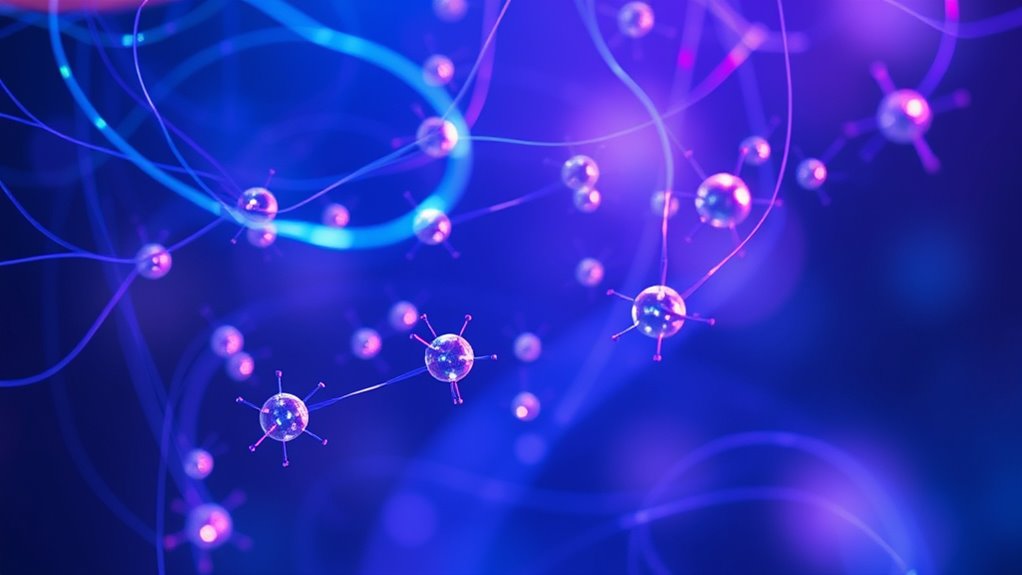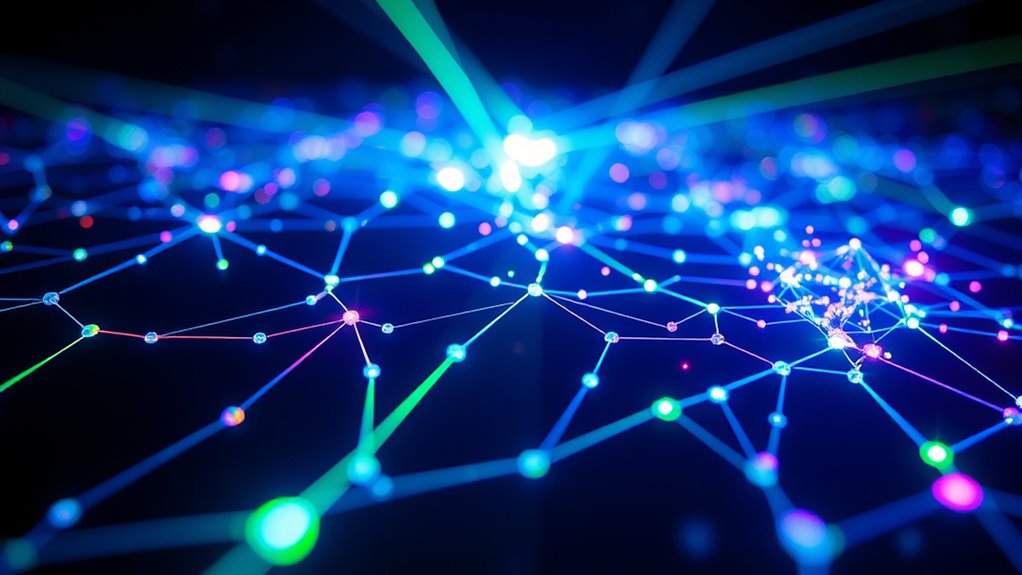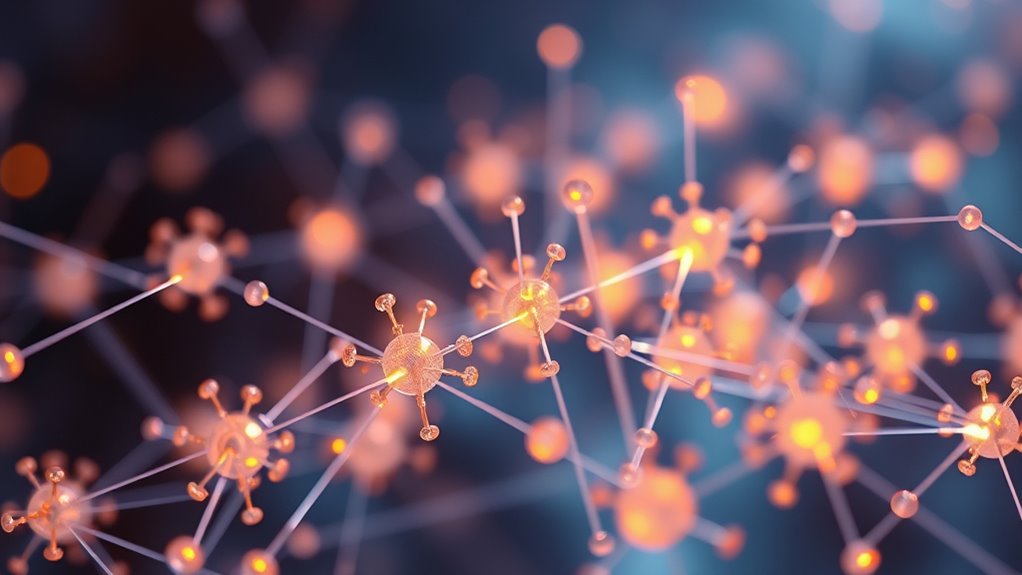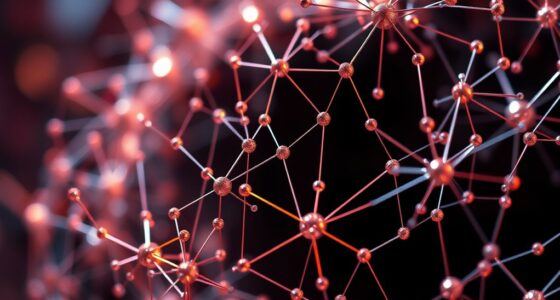You can control nanomachines using magnetic fields to guide their movement deep inside tissues, electric fields for precise navigation, and chemical gradients that induce chemotactic responses. Light offers another method, activating or steering nanomachines with high spatial and temporal accuracy. Combining these strategies allows for versatile, responsive control, but challenges like environmental variability remain. Staying informed about these techniques opens up exciting possibilities—keep exploring to discover more about mastering nanoscale navigation.
Key Takeaways
- External magnetic fields enable deep tissue navigation and precise, reversible control of nanomachines through magnetic alignment and forces.
- Electric fields allow high-accuracy guidance via localized potentials, microelectrodes, and dynamic adjustments for complex environments.
- Chemical gradients direct nanomachines through chemotactic responses, leveraging natural or engineered signaling for targeted delivery.
- Light-based control employs photochemical reactions and responsive materials for rapid, non-invasive, and spatially precise motion regulation.
- Combining external fields, chemical cues, and light enhances maneuverability, overcoming environmental challenges for applications in medicine and nanomanufacturing.
External Magnetic Fields and Their Influence

External magnetic fields play a crucial role in controlling nanomachines, as they can directly influence the movement and behavior of these tiny devices. When you apply a magnetic field, you create forces that guide nanomachines with precision. Magnetic nanoparticles inside the nanomachines respond by aligning their magnetic moments, causing them to rotate or move along the field lines. This allows you to steer nanomachines through complex environments, like blood vessels or tissue matrices. Unlike other control methods, magnetic fields penetrate deep tissues without attenuation, making them ideal for in vivo applications. By adjusting the field’s strength and orientation, you can achieve rapid, reversible, and remote control over nanomachine motion. This technique offers high specificity and minimal invasiveness, essential for targeted medical interventions. Furthermore, advancements in AI Security contribute to developing safer control algorithms, minimizing potential risks associated with autonomous nanomachine operations.
Electric Fields as a Tool for Nanomachine Guidance

Electric fields offer precise control over nanomachines through advanced manipulation techniques. By applying specific strategies, you can guide nanorobots with high accuracy for complex tasks. These methods are transforming applications in nanorobotics, enabling more effective and targeted operations. Understanding the fundamental principles of electromagnetism is essential for designing effective control systems for nanomachines.
Electric Field Manipulation Techniques
By applying carefully controlled electric fields, researchers can precisely guide nanomachines through complex environments. These techniques involve generating localized electric potentials to influence the nanomachine’s movement, orientation, or activity. You can manipulate the electric field’s strength, direction, and frequency to achieve desired trajectories, enabling navigation around obstacles or toward specific targets. Electric field manipulation often uses microelectrode arrays or patterned electrodes embedded in substrates, allowing fine spatial control. By adjusting parameters in real-time, you can steer nanomachines with high accuracy and responsiveness. This approach is especially useful for tasks requiring rapid adjustments or targeting specific regions within a biological or synthetic environment. Electric field techniques provide a versatile, non-invasive means to control nanomachine behavior without physical contact or chemical modifications. Additionally, understanding the 16PF traits of operators can enhance the effectiveness of these control methods by optimizing team coordination and responsiveness.
Precision Control Strategies
Precise control over nanomachines relies on carefully designed strategies that leverage electric fields to guide their movement with high accuracy. By applying carefully calibrated electric potentials, you can manipulate the nanomachine’s trajectory, speed, and orientation. Electric fields create forces that influence the particles’ charge distributions, enabling you to direct their paths in complex environments. These strategies often combine real-time feedback systems to adjust field parameters dynamically, ensuring precise positioning. You can also exploit electric field gradients to induce specific responses, such as rotation or selective attraction. The key is to optimize field strength and spatial configuration, minimizing unintended effects like heating or electrostatic interference. With these techniques, you gain fine-tuned control essential for intricate tasks in nanotechnology applications. Understanding the impact of electric field strength on particle behavior is crucial for achieving optimal guidance.
Applications in Nanorobotics
Guiding nanomachines in nanorobotics relies heavily on electric fields, which serve as a versatile tool for directing their movements with exceptional accuracy. By applying targeted electric fields, you can control the trajectory, speed, and orientation of nanomachines in real-time. This method allows for precise navigation within complex environments, such as biological tissues or microfluidic channels. Electric fields also enable manipulation of nanomachine functions, like cargo delivery or assembly tasks. You can modulate field strength and direction to adapt to changing conditions, making this approach highly flexible. As a result, electric field guidance enhances the capabilities of nanorobots, opening new possibilities for targeted therapies, diagnostics, and nanoscale manufacturing. This technology is transforming how you deploy and operate nanomachines in diverse applications.
Chemical Gradients and Chemotactic Behaviors

Chemical gradients serve as essential signals that direct nanomachines to their target locations. You can design nanomachines to sense specific chemical concentrations in their environment, allowing them to navigate toward higher or lower levels. This process, known as chemotaxis, enables precise movement without external intervention. As you introduce a chemical gradient, your nanomachines detect differences in concentration across their surface, prompting directional movement. By harnessing natural or engineered receptor systems, they can respond rapidly and accurately, reaching target areas like drug delivery sites or contaminated zones. Chemotactic behaviors improve efficiency and specificity, making nanomachines more effective in complex biological environments. This approach leverages the body’s natural signaling pathways, facilitating seamless integration and minimal disruption during medical or environmental applications. Incorporating nutrient-rich ingredients into the design can further enhance the responsiveness and functionality of nanomachines in biological systems.
Light-Driven Control Mechanisms

Light-driven control mechanisms harness photochemical activation techniques to trigger nanomachine responses precisely. By shining specific wavelengths, you can induce motion or change states in these tiny devices. This approach offers rapid, non-invasive control, making it a powerful tool for nanoscale manipulation. Understanding plant health can also help optimize these control methods for better results.
Photochemical Activation Techniques
Photochemical activation techniques harness light to precisely control nanomachines, enabling rapid and reversible switching of their functions. When you expose these systems to specific wavelengths, they undergo chemical changes that activate or deactivate their components. This method allows you to trigger actions with high spatial and temporal resolution, making it ideal for complex tasks. For example, incorporating photoresponsive molecules like azobenzenes or spiropyrans lets you modulate binding affinities, alter conformations, or initiate reactions instantly. You don’t need physical contact or external forces; light does the work. This approach offers minimal invasiveness and precise control over nanomachine behavior. By tuning light parameters, you can achieve a wide range of responses, making photochemical activation a versatile tool in nanotechnology. Additionally, understanding the power of decluttering can help manage the complexity of designing and controlling these systems effectively.
Light-Induced Motion Control
Light-induced motion control leverages the energy of photons to directly drive the movement of nanomachines, eliminating the need for external mechanical forces. By using light-sensitive materials or molecules, you can trigger specific conformational changes or directional movements upon illumination. For example, photoresponsive polymers bend or twist when exposed to certain wavelengths, causing nanoscale shifts. Light can also induce localized heating or generate photochemical reactions that propel nanomachines forward. This method offers precise spatial and temporal control, allowing you to activate or deactivate motion instantly. Additionally, you can tune the wavelength, intensity, and duration of light exposure to customize the behavior of your nanomachines, making light a versatile and non-invasive tool for controlling nanoscale systems efficiently. Crochet kits for beginners
Integrating Multiple Control Strategies

To effectively control nanomachines, researchers often combine multiple strategies rather than relying on a single method. By integrating external fields, chemical gradients, and light, you can achieve more precise and adaptable manipulation. For example, you might use magnetic fields to guide a nanomachine’s overall movement while employing chemical signals to trigger specific actions. Light can then be used to fine-tune or activate functions at targeted locations. This multi-faceted approach offers redundancy, increasing reliability in complex environments. It also allows you to tailor control schemes to specific tasks, improving efficiency and accuracy. Combining strategies enables you to address limitations inherent in individual methods, resulting in a versatile toolkit for steering the challenges of controlling nanomachines in real-world applications. Additionally, understanding the security implications of nanomachine control is essential to prevent misuse or malicious interference in sensitive environments.
Challenges in Precise Navigation at the Nanoscale

While combining control strategies enhances overall manipulation, steering nanomachines with pinpoint accuracy remains a significant challenge. At the nanoscale, even minor environmental variations can cause unpredictable deviations. Precise navigation requires overcoming issues like Brownian motion, which constantly jostles nanomachines, making controlled movement difficult. External influences, such as temperature fluctuations and fluid currents, further complicate navigation. Achieving exact positioning demands sophisticated feedback systems that can detect tiny shifts and adjust control inputs in real-time. Additionally, the limitations of current sensing technologies hinder accurate tracking of nanomachines’ locations. Together, these factors make it difficult to reliably direct nanomachines to specific targets, posing a major obstacle for their practical deployment in complex biological or industrial environments.
Future Perspectives in Nanomachine Control

What does the future hold for nanomachine control as technology advances? You can expect more precise and versatile manipulation methods. Innovations in external field techniques, like magnetic and electric fields, will become more refined, enabling better targeting and movement. Light-based control will likely expand, offering faster, non-invasive activation of nanomachines. Chemical gradient navigation may evolve with smarter, adaptive systems that respond to complex environments. Integration of artificial intelligence and machine learning will enhance real-time control, making nanomachines more autonomous and efficient. These developments will open new applications in medicine, environmental sensing, and manufacturing. As control strategies improve, you’ll have greater confidence in deploying nanomachines for delicate tasks, pushing the boundaries of what’s possible at the nanoscale.
Frequently Asked Questions
How Do Environmental Factors Affect Nanomachine Control Accuracy?
Environmental factors markedly impact your nanomachine control accuracy. Variations in temperature, chemical composition, and fluid flow can cause unpredictable behavior or reduce precision. External disturbances like electromagnetic noise or light interference may disrupt control signals. You need to carefully monitor and adapt to these conditions, perhaps by adjusting external fields or calibrating sensors, to maintain precise movement and functionality of your nanomachines in changing environments.
Can Nanomachines Operate Independently Without External Guidance?
Can nanomachines operate independently without external guidance? While some designs aim for autonomous function, most rely on external cues for precise control. Imagine tiny robots steering through complex environments—without external guidance, they’d struggle to coordinate and achieve specific tasks. You’ll find that, currently, nanomachines need external fields, chemical signals, or light to function effectively, ensuring they act accurately and purposefully rather than aimlessly wandering.
What Are the Ethical Considerations of Deploying Nanomachines in Vivo?
You must consider ethical issues like safety, privacy, and informed consent when deploying nanomachines in vivo. You need to guarantee they don’t cause harm or unintended side effects, respect patient autonomy, and address potential misuse or malicious applications. Transparency about risks and benefits is essential, and you should follow strict regulations. Balancing innovation with responsibility helps protect individuals and maintains public trust in nanotechnology advancements.
How Scalable Are Current Nanomachine Control Methods for Medical Applications?
You find that current nanomachine control methods are somewhat scalable for medical applications, but challenges remain. External fields, chemical gradients, and light can be precisely targeted in lab settings, yet translating this to complex human bodies requires further development. You’ll need more advanced, non-invasive techniques that guarantee safety and reliability across diverse tissues. While progress is promising, widespread clinical use demands scalable, adaptable control systems that can handle individual variability.
What Are the Potential Risks of Uncontrolled Nanomachine Navigation?
Uncontrolled nanomachine navigation is like releasing a wild horse—you might cause damage or unintended effects. You risk tissue damage, immune responses, or even malfunctioning devices that could harm your body. If they drift off course, nanomachines could target the wrong cells or release harmful substances, leading to serious health issues. Ensuring precise control is essential to prevent these risks and protect your safety during medical treatments.
Conclusion
As you harness external fields, you paint a guiding map in the nanoscale landscape, steering tiny machines through glowing chemical trails and shimmering light patterns. With each control method, you shape a vibrant, dynamic universe where nanomachines dance to your commands. Though challenges remain, your mastery over these invisible forces transforms the microscopic sphere into a playground of endless possibilities, opening doors to breakthroughs that will redefine what’s achievable at the tiniest scales.









